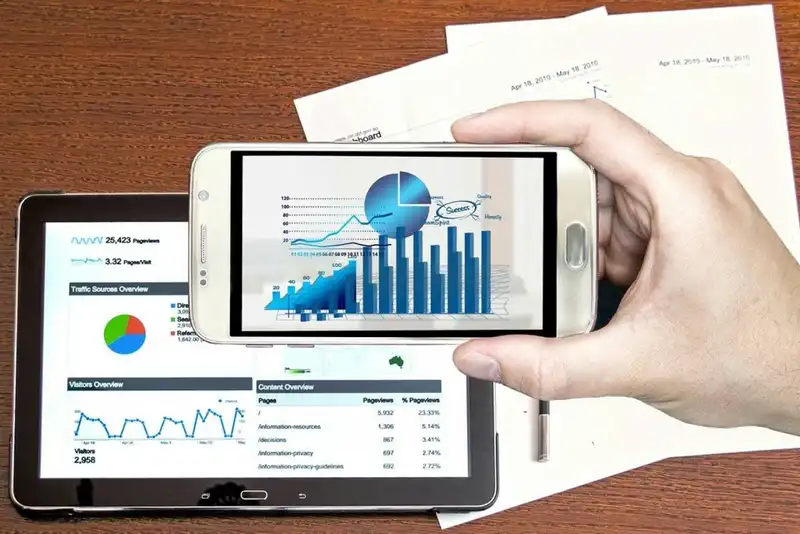What is best business intelligence software ?
Business intelligence software is the software that helps companies produce and analyze data or information. The best business intelligence software can help organizations make decisions about their resources by gathering, analyzing, and presenting relevant information in a clear and accessible manner.
How to Shop for the Best Business Intelligence Software for Restaurants
What is Business Intelligence Software?

All businesses produce data through the point of sale (POS) systems, business management software, or employee management tools.
Business intelligence software refers to computer programs that help organizations in data discovery, data gathering, data analysis, and management of business information. The analysis of these data sets allows an organization to identify, develop and create business strategies.
Business intelligence or BI technologies help in the easy interpretation of big data and in data mining so that new opportunities can be identified, and an effective strategy can be built to provide businesses with a competitive edge in the market and long-term stability.
BI software, therefore, allows companies to make both operational decisions like those related to product positioning or pricing, and tactical decisions like those related to priorities and objectives. The best decisions are taken by juxtaposing data derived from the market with the company's internal data, like those concerning finance and operations.
What are BI tools?

BI tools or business intelligence tools are types of software that help in the collection and processing of considerable amounts of unstructured data from both external and internal sources, including documents, files, journals, health records, emails, images, videos, and so on.
Business intelligence tools may not be as flexible as business analytics tools, but the former facilitates the amassing of data to look for information primarily through questions.
A business intelligence tool also allows an organization to prepare data for the purpose of analysis so that reports, dashboards, and data visualizations can be created.
The results give the management and employees the ability to boost decision making, improve operational efficiency, identify new revenue opportunities, spot market trends, and report genuine key performance indicators (KPIs).
A business intelligence tool is typically used for simpler questioning and reporting of business information. A business intelligence tool is able to bring together a wide range of data analysis applications, including ad hoc questioning and analysis, online analytical processing (OLAP), mobile business intelligence, enterprise reporting, real time business intelligence, open-source business intelligence, cloud-based business intelligence, software as a service business intelligence, location intelligence, collaborative business intelligence, and operational business intelligence.
A business intelligence tool may also deal with data visualization software that allows the designing of charts, and also with tools for creating BI dashboards and performance scorecards that highlight business metrics and KPIs and let company data be brought to life in the form of easy to understand and easy to use visuals.
Restaurants are under pressure to provide the best service and food, but they’re also under pressure to keep up with their competitors.
Business intelligence software is essential for restaurants to remain competitive in today's market. This article tells you everything about it.
Difference Between Data Reporting and Data Analytics

1. Reporting essentially refers to pulling out data from various sources, organizing them into summaries, and monitoring them to comprehend the performance of the various parts of a business.
With the help of reports, data can be linked across functions so that a cross-channel view is possible. This would, in turn, facilitate comparison, and the data can be easily made sense of.
For instance, reporting may produce a profit-loss statement, a comparison of profit margins between specific periods of time, or a summary of the labor hours recorded this year and those recorded last year during the holiday season.
Analysis, on the other hand, involves inspecting reports to interpret data at a deeper level and gain insights that would allow recommendations to be made. Analytics don't stop at 'what', but look at 'why', 'how' and 'what next?'
2. Reporting entails activities like building, consolidating, configuring, organizing, formatting, and summarizing. It feeds on clean, and raw data generated by daily, weekly, monthly, quarterly, and/or yearly reports.
Analysts then interpret that data by examining, and comparing it. Data analysis involves questions being asked to make sense of the data provided by the periodic reports. Big data can provide a peek into future trends as well.
3. Reporting involves outputs like dashboards and alerts that provide information to users. Analysis, on the other hand, deals with efforts to get answers to business queries so that they can be presented as ad hoc responses, insights, recommendations, or forecasts.
4. Reporting involves repetitive tasks that can be automated. Reports are often used by functional heads of organizations to track specific business metrics.
Data analysis, on the other hand, is all about customization, and making data comprehensible and useful to cater to specific queries of the business. Analysis, therefore, relies on data analysts and data scientists and is used by the company management to make decisions that are firmly rooted in data.
How Can Business Intelligence Software Push up Profits?

1. Sales data pulled from the POS system can let a restaurant know which are its most popular items, and which receive only a lukewarm response.
Analysis of these reports can, therefore, help a restaurant owner take decisions that are critical to Business Growth, telling them which items to retain, produce more, and promote more, and which items to strike off the menu so that profits can be maximized.
Data analysis explains the relationship between popularity and profitability of specific menu items, and a restaurant owner who is able to identify the top-selling items and those with the highest profit margins can make better decisions on strategic promotion of items. They can also adjust pricing wherever needed.
2. Business intelligence also involves the analysis of POS reports to predict future sales and revenue. Past sales can be analyzed to reveal trends and forecast future revenue, on the basis of which costs can be adjusted, inventory levels can be planned, labor hour allocations can be worked out, and generally, strategies can be made to meet business goals.
3. Reports and analytics help in robust inventory management by businesses. For example, a restaurant, by looking at the sales data, would know which items have depleted and must be reordered, and which are the ones that are in good supply and need not be immediately purchased. The Food Supply chain can, therefore, be effectively managed with the help of data.
A proper understanding of the variation between theoretical and actual food usage would allow restaurants to make the necessary adjustments to their strategies. This would help improve Order Management practices, and predictive analysis tools such as smart ordering let restaurants choose optimized orders on the basis of stock levels and sales forecasts. Machine learning is able to improve the accuracy of sales forecasts.
The right data can also help in identifying the areas of food loss. The employees can then be trained and made accountable in order to prevent food wastage.
Multi-store restaurants can identify the most and least profitable stores with the help of data.
4. Sales data extracted from POS systems can help in identifying a restaurant's busiest and slowest periods of traffic. Employees can then be scheduled accordingly with an eye on cutting labor costs, which constitute a restaurant's biggest expenses.
POS systems also provide a wealth of data on points like revenue per employee, revenue per employee per month, revenue per time slot, the strongest and weakest performers, hours worked, peak hours worked, and so on. They may also act as employee time clocks. Employee data gleaned from the POS system allow managers to make better schedules, optimize staff time and make training more effective.
6. Customer information recorded by POS systems helps businesses identify their most loyal customers, who can then be incentivized in the form of loyalty programs. It can also be used to generate repeat orders from one-off customers.
Today, personalized marketing is becoming more and more common and customers are being targeted through email marketing, phone messages, and social media marketing. Data can also be used to receive customer feedback so that reward programs can be refined further.
What to Look for in Business Intelligence Platforms?

1. One of the key features of a good Business Intelligence platform is its ability to easily connect with the company data. The platform should allow the business user to access and analyze the data live, without having to download it, and should integrate seamlessly with the company's existing data strategy rather than compelling the user to purchase additional products.
2. The total cost of ownership of a BI platform should be considered. A Small Business, especially, may choose open-source software for data mining and ad hoc reporting requirements. However, one needs to consider that 'free' tools are anything but free, and the final cost may be substantial. Also, open-source software may not be too flexible as the organization scales up.
3. The right BI platform empowers users to interpret data and leverage insights, and use them to drive business decisions. The value of data can be maximized by deploying governed self-service analytics at scale. One should prefer such a BI platform that enables IT to create a secure environment to protect data without compromising innovation.
4. A BI platform should be able to create and customize dashboards and allow the preparation of modules, graphs, and charts that can be updated in real time. The platform should offer useful visual insights.
5. One should choose a BI platform company that looks to make processes data-driven, and which has years of research and development experience. One should look at the company's history and its priorities, and also consult user reviews before adopting its BI platform.
6. The right BI platform would be flexible, easy to use, can scale effortlessly as the business grows, and should be able to help a business reach its goals.
You’re keen on using business intelligence software in your operations, but you’re not sure which one to buy.
This article will walk you through the best business intelligence software solutions in the market and guides you towards the one you need.
5 Best BI Software for Restaurants
1. Zip Reporting- This software solution from Hubworks offers a streamlined way to access and understand data quickly, anytime, from anywhere, and across multiple devices. It saves time and effort needed to manually wade through layers of data. Cloud-based syncing allows data to be accessed in real time. Zip Reporting simplifies the complexities of business into actionable insights.
2. Dundas BI- The Dundas BI platform is offered by Dundas Data Visualization. It is a browser-based BI and data visualization platform. It includes integrated dashboards, reporting, and data analytics tools. Dundas BI allows users to create interactive, customizable dashboards, create their own reports, run ad hoc questions, and analyze data and performance metrics in detail.
3. Zoho Analytics- It is a BI and analytics solution that lets users build insightful reports and dashboards. It helps users visually analyze business data and make informed decisions.
4. Power BI- The Microsoft Power BI solution transforms the organization's data into high-quality visuals so that the business can focus on what customers want. Power BI is a collection of business analytics tools for separating data and providing insights. Answers can be received immediately with the help of dashboards. Power BI allows the user to share insights with numerous data visualizations, Excel integration, pre-built and custom data connectors, and built-in artificial intelligence abilities.
5. Restaurant365- It is a software as a service (SaaS), restaurant-specific operations and accounting platform. It integrates with POS, vendors, banks, and the payroll management system to offer strong reporting features. It saves time and allows operators to make profit-driven decisions.
BI Software FAQs

1. Can small and medium businesses afford Business Intelligence solutions?
Accessing, modeling, visualizing, and reporting business data would have been out of reach for all, but large organizations until a few years ago. However, cloud-based technologies today have pushed down the costs of BI solutions and made them more accessible for small, to medium enterprises.
2. How is BI software different from ERP (enterprise resource planning)?
BI solutions deal with high-level discussions for making meaningful, tactical decisions. These solutions access the entire company databoth strategic (related to revenue, growth, and profit), and operational (related to daily sales). An ERP, on the other hand, is a system for generating an exact operational picture of the organization, often without data comparison, trend analysis, or generation of insights.
3. Is it possible to make business data secure?
The key requirements for any IT system are data security and availability. A BI solution must be able to match the same high standards of performance, security, and reliability that are expected of other systems of the organization. Reputed BI solutions take advantage of existing security infrastructures for keeping data secure.
4. How can BI software be put to use?
From the perspective of implementation, BI consists of a set of processes and technologies for converting raw data into information that can be made sense of. It involves designing, modeling, shaping, and visualization. This helps drive profitable business actions.
Successful implementation of BI software makes use of a circular approach, beginning simple, challenging assumptions and improving outcomes. The end objective, however, is to produce a series of reports and dashboards that present data in a meaningful, accessible, and attractive way.
5. What machine learning interview questions are common?
If one decides to land a BI job, he/she would have to begin preparing for interviews. The following are the common machine learning interview questions-
- What are control and data flow?
- How are data transformation services different from SQL Server Integration Services (SSIS)?
- What is SSIS, and how does SSIS relate with SQL Server?
- How can SSIS Executions be logged?
Business intelligence software is critical for restaurants to get the most out of their operations.
This article introduces you to the best business intelligence software in the market, laying out their features, pricing, and more.






























































































































































